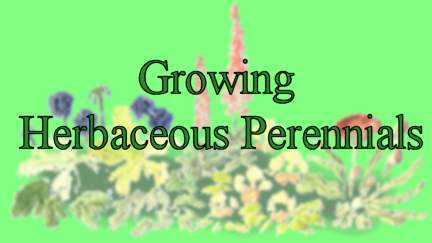

The most important consideration when preparing beds for planting herbaceous perennials is the meticulous removal of all perennial weeds and their roots. Ground elder, couch grass and convolvulus are the worst weeds, because if a small piece of their root is left in the soil rapid recolonisation of these invasive species will follow. Digging through the area several times is recommended and it is also better to leave the area for a period of several weeks after digging to see if any missed pieces of roots are shooting. In severe infestations it may even be worthwhile to grow a crop of potatoes prior to planting up with perennials in order to be able to fully eradicate these types of weed. Translocated herbicides such as Roundup (glyphosate) may be used to control perennial weeds but are not very effective on the weeds mentioned above. For a period of weeks after the bed has been planted it is important to check for the presence of perennial weeds and remove them completely. It is best to spend a little time on weed removal at this stage, because it will save a lot of work later.
A good humus rich soil will be black in colour and will provide an ideal growing medium. A soil which is orange or pale brown will be deficient in organic material and this will have to be enriched by adding either garden compost, well rotted farmyard manure, mushroom compost or garden peat. It is better to incorporate the greater part of the organic material in a layer perhaps a foot or more below the surface. This will help to retain moisture during a hot summer and will not cause too much water retention in the surface layers during a wet winter. An orange soil will consist of either clay or sand. Sandy soils can be recognised by a gritty abrasive texture when the soil is rubbed in the hand. Sandy soils will require the addition of a lot of organic material in the areas where moisture loving plants are to be grown. When a clay soil is compressed in the hand it will maintain it's form after it is released.Wet clay soils will have the consistency of soft plasticine. Clay soils will need the addition of a lot of organic matter well worked through and also the addition of sand or chippings to increase the drainage properties. It may take a number of years to improve a poor clay soil to a reasonable standard. If a clay soil causes a lot of waterlogging after heavy rain, either moisture loving plants can be used or otherwise the site should be drained using perforated plastic drainage pipes, surrounded by sand in deep trenches, with a gradient which will run the water away from the site.
Aim to choose plants with form and structure and also flowering potential. Irises and kniphofias produce upright foliage which helps to add form and structure to a border. If the border is narrow and visible from both sides select plants which are not too tall. A good guide is to select plants which are not higher than half of the width of the border. Traditional herbaceous borders are backed by an evergreen hedge of yew, etc. In these borders higher plants can be used at the back.The island bed surrounded by lawn on all sides is now becoming increasingly popular. Ideally plant in groups of three or five. Planting density will normally be 5 or 6 plants per square metre. plants which shoot and flower early can be placed further back even though they are quite short. Spring bulbs fall into this category and their remaining leaves after flowering will be hidden as the other plants grow up. It is not always necessary to plant tall at the back and short at the front. If a medium or tall plant has a good form and structure, it can be used at the front of a border, as long as the other plant heights grade into it ie. it is better not to have lower plants behind. Choose plants for the front of a border which have good foliage form all through the growing season. A restrictive colour scheme can be followed or I believe it is better to just go for a mixed planting and then you can choose the types and varieties of plants that you prefer.Aim for a few spring flowering varieties with the majority flowering through the Summer, which is the period when you are likely to be spending most time in the garden. It is often a good idea to have a small bed that is visible from the house, planted up with earlier flowering varieties.
The ideal planting time is April and May or late August and September. It is best not to plant when the soil is too wet or too cold.
It is a good idea to choose a warm and dry period early in the year to hoe through the bed, before an increased growth of foliage hides all the weed seedlings. Hoeing on a regular basis is the easy way to keep the weeds down and only takes a few minutes. When the soil surface is loosened through hoeing this prevents excessive water loss by disrupting the capillary action to the soil surface. The drier soil surface will also inhibit further weed germination.
After certain plant types have finished flowering they can be cut back to initiate a second flowering flush. Many of the hardy perennials respond particularly well to this course of action. it may also be beneficial to keep an eye out for insect pests and deal with these as the need arises. All of the plants can be tidied up a little in the autumn, but it is probably best to wait until early spring before cutting the dead growth hard back.
Follow Up Maintenance
Last updated Jan 2001